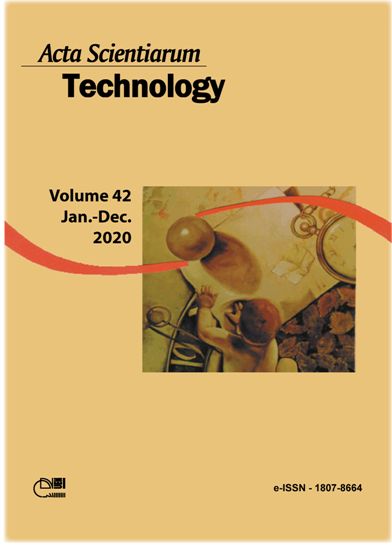Characterisation of a “green†lipase from Aspergillus niger immobilised on polyethersulfone membranes
DOI:
https://doi.org/10.4025/actascitechnol.v42i1.44498Keywords:
agroindustrial residue; enzyme; catalysis; polymeric supports.Abstract
In this work, a “green†Aspergillus niger lipase obtained from the solid-state fermentation of Hancornia speciosa (“mangabaâ€) seeds was efficiently immobilised on polyethersulfone membranes (PES) by physical adsorption (PES-ADS-lipase) and covalent bonding (PES-COV-lipase) (immobilisation yields of 92 and 81%, respectively). The free lipase showed an optimum pH close to neutrality, while the biocatalysts displaced the pH to the alkaline region (optimum pH 9.0 and 11.0 for PES-ADS-lipase and PES-COV-lipase, respectively). The optimum temperature of free lipase was 55°C; however, a higher thermal stability occurred at 37°C. The PES-ADS-lipase and PES-COV-lipase showed lower optimum temperatures (37 and 45°C, respectively) but higher thermal stabilities at 45 and 55°C, respectively. The lower thermal inactivation constant and higher half-life of PES-COV-lipase at 55°C confirmed the efficiency of covalent bonding in maintaining the thermal stability of the enzyme. The Michaelis - Menten constant (Km) and maximum rate of reaction (Vmax) were also determined, and the biocatalysts showed higher affinities to substrates (lower Km values) than free lipase. In this work, the biocatalysts showed good catalytic properties with future potential applications in hydrolysis reactions. The use of a “green†lipase obtained from agroindustrial residue makes this product economically attractive from an industrial point of view.
Downloads
Downloads
Published
How to Cite
Issue
Section
License
DECLARATION OF ORIGINALITY AND COPYRIGHTS
I Declare that current article is original and has not been submitted for publication, in part or in whole, to any other national or international journal.
The copyrights belong exclusively to the authors. Published content is licensed under Creative Commons Attribution 4.0 (CC BY 4.0) guidelines, which allows sharing (copy and distribution of the material in any medium or format) and adaptation (remix, transform, and build upon the material) for any purpose, even commercially, under the terms of attribution.
Read this link for further information on how to use CC BY 4.0 properly.















8.png)




